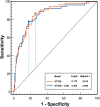Association of obesity- and insulin resistance-related indices with subclinical carotid atherosclerosis in type 1 diabetes: a cross-sectional study
- PMID: 40319311
- PMCID: PMC12049799
- DOI: 10.1186/s12933-025-02736-2
Association of obesity- and insulin resistance-related indices with subclinical carotid atherosclerosis in type 1 diabetes: a cross-sectional study
Abstract
Background: Obesity and insulin resistance are well-established risk factors for atherosclerosis and cardiovascular disease (CVD). Although some obesity- and insulin resistance-related indices (OIRIs) have been linked to CVD, their associations with subclinical carotid atherosclerosis (SCA) in individuals with type 1 diabetes (T1D) remain unclear. This study aims to systematically explore and compare the associations of various common OIRIs with SCA in T1D population.
Methods: A total of 418 adult inpatients with classic T1D admitted from October 2008 to June 2021 to the First Affiliated Hospital of Air Force Medical University in Xi'an, China were included in this study. Demographic, anthropometric, and laboratory data were collected. Studied OIRIs comprised body mass index, waist-to-height ratio, waist-to-hip ratio (WHR), a body shape index, abdominal volume index, body adiposity index, body roundness index, conicity index, triglyceride-glucose index, visceral adiposity index, Chinese visceral adiposity index (CVAI), lipid accumulation product, estimated glucose disposal rate (eGDR), triglyceride-to-HDL ratio, and cardiometabolic index. Binary logistic regression, restricted cubic spline (RCS), and receiver operating characteristic curves were used to examine the associations of these indices with SCA.
Results: In multivariable logistic regression analyses, after adjusting for potential confounders, per 1.0-standard deviation (SD) increase in CVAI (OR, 95% CI: 1.68, 1.16-2.47), eGDRWHR (eGDR calculated with WHR; OR, 95% CI: 0.44, 0.22-0.82), and eGDRWC (eGDR calculated with waist circumference; OR, 95% CI: 0.49, 0.24-0.93) were significantly associated with SCA. CVAI exhibited the highest area under the curve (AUC) in diagnosing SCA, with a value of 0.73 (95% CI: 0.69-0.77). RCS analyses indicated a linear and positive association between CVAI and SCA in the overall population and the females. Subgroup analyses and sensitivity analyses further supported the association between CVAI and SCA. Additionally, adding CVAI to the Steno Type 1 Risk Engine (ST1RE) improved the reclassification, but did not enhance the overall discriminative ability of ST1RE to identify SCA.
Conclusion: Among various OIRIs, CVAI shows the strongest association with SCA in adults with T1D. These findings suggest that CVAI may merit further longitudinal investigation as a potential marker for SCA assessment in this population.
Keywords: Chinese visceral adiposity index; Insulin resistance; Obesity; Subclinical atherosclerosis; Type 1 diabetes.
© 2025. The Author(s).
Conflict of interest statement
Declarations. Ethics approval and consent to participate: This study was approved by the Ethics Review Committee of the First Affiliated Hospital of Air Force Medical University (Approval No. KY20240001301). Informed consent was obtained from all participants included in the study. Consent for publication: Not applicable. Competing interests: The authors declare no competing interests.
Figures





Similar articles
-
LIPID ACCUMULATION PRODUCT, VISCERAL ADIPOSITY INDEX, AND CHINESE VISCERAL ADIPOSITY INDEX AS MARKERS OF CARDIOMETABOLIC RISK IN ADULT GROWTH HORMONE DEFICIENCY PATIENTS: A CROSS-SECTIONAL STUDY.Endocr Pract. 2018 Jan;24(1):33-39. doi: 10.4158/EP-2017-0007. Epub 2017 Nov 16. Endocr Pract. 2018. PMID: 29144802
-
Comparison of obesity indicators for predicting cardiovascular risk factors and multimorbidity among the Chinese population based on ROC analysis.Sci Rep. 2024 Sep 9;14(1):20942. doi: 10.1038/s41598-024-71914-1. Sci Rep. 2024. PMID: 39251694 Free PMC article.
-
Dose-response association between Chinese visceral adiposity index and cardiovascular disease: a national prospective cohort study.Front Endocrinol (Lausanne). 2024 Apr 18;15:1284144. doi: 10.3389/fendo.2024.1284144. eCollection 2024. Front Endocrinol (Lausanne). 2024. PMID: 38699393 Free PMC article.
-
Optimal obesity- and lipid-related indices for predicting type 2 diabetes in middle-aged and elderly Chinese.Sci Rep. 2024 May 13;14(1):10901. doi: 10.1038/s41598-024-61592-4. Sci Rep. 2024. PMID: 38740846 Free PMC article.
-
Age-Related Changes in Glucose Metabolism, Hyperglycemia, and Cardiovascular Risk.Circ Res. 2018 Sep 14;123(7):886-904. doi: 10.1161/CIRCRESAHA.118.312806. Circ Res. 2018. PMID: 30355075 Free PMC article. Review.
References
-
- Williams R, Karuranga S, Malanda B, Saeedi P, Basit A, Besancon S et al. Global and regional estimates and projections of diabetes-related health expenditure: results from the International Diabetes Federation Diabetes Atlas, 9th edition. Diabetes Res Clin Pract. 2020;162:108072. - PubMed
-
- Verges B. Cardiovascular disease in type 1 diabetes: a review of epidemiological data and underlying mechanisms. Diabetes Metab. 2020;46(6):442–49. - PubMed
MeSH terms
Substances
LinkOut - more resources
Full Text Sources
Medical

